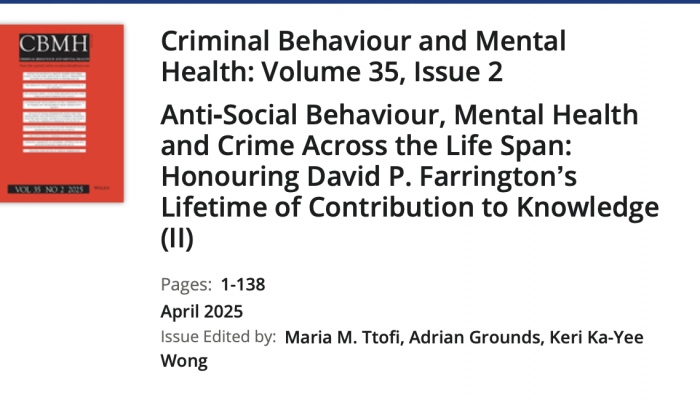Special double issue in honour of Professor David P. Farrington

CBMH guest editors (Maria Ttofi, Adrian Grounds and Keri Wong) would like to draw your attention to a doubled special issue in Criminal Behaviour and Mental Health on ‘Anti‐social behaviour, mental health and crime across the lifespan’ which was set up in honour of Professor David P. Farrington, one of the founding editors of CBMH. David Farrington, OBE, was a Fellow of the British Academy, of the Academy of Medical Sciences, of the British Psychological Society, and the American Society of Criminology. The doubled edited issue of CBMH features four invited editorials from leading experts in the field of developmental criminology, youth violence and crime prevention, followed by original contributions from eleven prospective criminological cohort studies from the USA, Europe, Asia and Australia.
Volume 35, Issue 1 starts with two invited editorials by Lawrence Sherman and David Weisburd. Inspired by David's legacy, Lawrence Sherman coins the term ‘Farrington curve’ to reflect on the importance of separating out the differences in cumulative harm between median offenders and the most extreme outliers; and further links this idea to recent work on VAWG. David Weisburd comments on the importance of prioritising high‐quality experimental research, and when possible, prioritising randomised trials implemented with high fidelity. Following David Farrington's legacy, he reflects on the importance of ‘telling the truth’, regardless of one's ideological predispositions; that is, openly describing what the evidence says as well as being clear about the limitations of the evidence, even if the evidence sometimes contradicts what we think is true or what we would like to be true. The first special issue then features longitudinal data analyses on antisocial behaviour, mental health and crime across the lifespan from Germany (the Erlangen-Nuremberg Development and Prevention Study; Lösel et al.); United States (the Community Youth Development Study; Halvorson et al.); Brazil (the 1982 Pelotas Birth Cohort Study; Gomes et al.); China (the Chinese Jintan Child Cohort Study; Liu et al); Australia (the Longitudinal Survey of Australian Children; Halls & Edwards); and from a longitudinal/shorter-term follow-up study in a Northeastern region of the United States (Kofler et al.). The link to CBMH 35 (1) is here.
Volume 35, Issue 2 starts with two invited editorials by Louise Arsenault and Lila Kazemian. Following in the footsteps of David, who has long studied bullying behaviours and their developmental impact, Louise Arsenault reflects on the most up-to-date scientific research on this topic, but within a developmental psychology perspective and with a mental health focus. Then, Lila Kazemian comments on the emergent influence and untapped potential of DLC research. Concrete real-life examples are given on how DLC researchers have provided data-informed insights to guide policy and practice. This second special issue then features longitudinal data analyses on antisocial behaviour, mental health and crime across the lifespan as well as reflections on the future planning/development of existing cohort studies from the UK (the Cambridge Study in Delinquent Development; Jolliffe et al.); the US (the Cambridge -Somerville Youth Study; Welsh); Switzerland (the z-proso study; Eisner et al); the UK (the Peterborough Adolescent and Young Adult Development Study; Treiber & Wikstrom); and the US, based on administrative longitudinal data of over forty three thousand individuals released from incarceration in the State of Texas (Narvey et al.). The double edited issue concludes in a celebratory way with the inclusion of short personal dedications from friends, collaborators, colleagues and scholars who knew David P. Farrington. The link to CBMH 35(2) is here.
The link to personal contributions to David P. Farrington is here.
